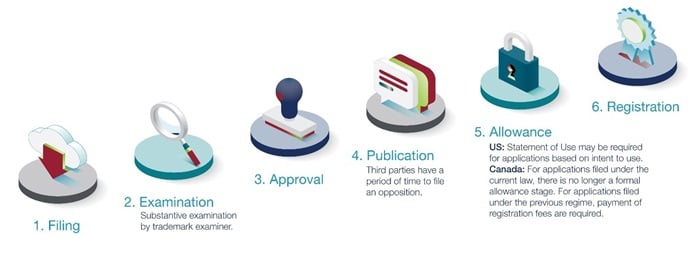When it comes to international expansion, Canada is often considered a natural fit for United States companies. There are strong economic and geographical ties between the two countries, and Canada offers a stable consumer base that is highly familiar with U.S. culture and cross-border shopping. However, it is important for U.S. companies to recognize that their U.S. trademark rights do not automatically apply in Canada. Instead, specific steps are required to protect their brands north of the border.
While the two countries’ trademark systems share many similarities, there are important differences, especially since significant amendments to Canada’s Trademark Act came into force in June 2019. Below is a guide to assist U.S. companies in understanding and navigating the two countries’ trademark systems.
Legal framework
The general legal framework is similar between the United States and Canada. Generally speaking, trademark rights may arise through (i) use of a trademark in the normal course of trade at common law, or (ii) registration of a trademark.
That being said, there are some differences between the two countries’ trademark registers. The U.S. offers federal registrations and state registrations. A federal registration may be on the Principal Register or the Supplemental Register (for marks that are in use but do not qualify for the Principal Register, such as marks that merely describe some feature of the goods/services, but may over time become an indicator of source). In contrast, Canada has only a Federal Register, and there is no separate registration system for trademark protection in the different Canadian provinces and territories.
As compared to unregistered trademarks (common law), which only give protection to the particular geographic area in which a mark is used, a federal registration in the U.S. or a national trademark registration in Canada gives brand owners the exclusive right to protection throughout the country, regardless of the geographical area of use.
Registration process
General steps
The general steps for obtaining a trademark registration in the U.S. and Canada are somewhat similar, as set out below:

Timeline
The timeline to register a trademark is typically much longer in Canada compared to the U.S. This is largely because there is a significant difference between the countries with respect to the period of time between the filing of an application and the examination of the application by the trademarks office. At the time of this article, a U.S. application is typically examined three to six months after filing, but the same would take about 22 to 24 months in Canada. Overall, it may take about 9 to 12 months to register a trademark in the U.S. and about 2.5 to 3 years in Canada.
The longer timeline to register a trademark in Canada makes it important for U.S. companies to seek protection early, especially if a trademark registration is an important aspect of an applicant’s business plan.
Identification of goods and services
Both trademarks offices require a high degree of specificity in how the goods and services are identified. Both countries use the Nice Classification system. However, an acceptable description in the U.S. may not be considered sufficiently specific in Canada, as illustrated by the following example:
|
Identification |
Europe> |
U.S. |
Canada |
|
“Computer software” |
Acceptable |
Not Acceptable |
Not Acceptable |
|
“Downloadable software for processing images, graphics and text” |
Acceptable |
Acceptable |
Not Acceptable |
|
“Downloadable software for processing images; word processing software” |
Acceptable |
Acceptable |
Acceptable |
Practically speaking, while the identification from a U.S. application is a good starting point, it is often necessary to consult with a Canadian trademark professional to meet the Canadian specificity requirements.
Filing bases and trademark use
When filing a trademark application in the U.S., an applicant must state a filing basis. An application filed based on “use in commerce” must be accompanied with a specimen of use at filing or during examination. Similarly, if an application is solely filed based on “intent to use,” the applicant will be required to file a Statement of Use and a specimen of use before a Certificate of Registration can be issued. Essentially, these requirements make trademark use a prerequisite to obtain a U.S. registration (unless the application is filed based on a foreign registration).
Historically it was necessary to identify a filing basis in Canada; however, since changes to Canada’s Trademarks Act came into effect on June 17, 2019, a filing basis is no longer required. Based on current law, trademark use is no longer required to obtain a Canadian registration. However, in order for an application and the issuing registration to be valid, an applicant must be using or have a bona fide intention to use the mark in association with the goods or services specified in the application once the application is filed. Also, use remains an important concept in Canadian trademark law in the context of non-use cancellation proceedings and enforcement.
In addition, Canada is now a country member of the Madrid Protocol, along with the U.S. This means that the Madrid Protocol can be used by U.S. companies to file one application in the U.S. and subsequently apply to extend such protection to other countries/jurisdictions such as Canada, through one application and paying a single filing fee based on the number of countries/jurisdictions.
Unregistrable terms and supplemental register
As a general rule, clearly descriptive terms are not registrable as trademarks in both the U.S. and Canada. There are exceptions to this general rule in both countries, including:
- In the U.S., marks that merely describe some feature of the goods/services that are in use, but not yet eligible for registration on the Principal Register, may be registered on the Supplemental Register and may, over time, become an indicator of source. There is no equivalent to the Supplemental Register in Canada.
- Another exception is that descriptive marks may be registered if it can be proven with evidence that the mark has “acquired distinctiveness” (also known as “secondary meaning”) through use. While this concept exists in both countries, the nature of evidence required to successfully enter a claim of acquired distinctiveness may be different. In the U.S., an applicant may file various forms of evidence, including a verified statement that the mark has become distinctive of the applicant’s goods or services by reason of the applicant’s substantially exclusive and continuous use of the mark in commerce for five years. In Canada, affidavit evidence is required. Typically, the affidavit should be accompanied by specimens of the trademark, statements which clearly indicate the extent of use of the mark for each territorial area (e.g., sales figures per province) and other evidence to demonstrate reputation. If the evidence shows the mark became distinctive in only some areas of the country, protection may be restricted to a defined territorial area.
Similarly, marks that are primarily merely a surname are not typically registrable in both countries and the same exceptions apply.
In addition to the above, a new ground of refusal at the examination stage was introduced in Canada as part of the changes to its trademark law. Trademark examiners may now raise an objection on the basis that a mark is not inherently distinctive. For example, marks that consist of geographic locations, generic designs, names of colours, one letter or number marks, laudatory phrases and phone numbers are generally considered to be not inherently distinctive by the Canadian Intellectual Property Office. Although there are some guidelines in the Canadian Trademarks Examination Manual, the courts have not yet considered this issue. This new objection has made it more challenging to register inherently weak marks.
Letter of protest (United States)/Notification of third-party rights (Canada)
Both countries have an informal procedure that allows third parties to file submissions with the trademarks offices regarding issues that relate to the registrability of a mark.
In Canada, a Notification of Third Party Rights is limited to the following three grounds:
- Confusion with a registered mark;
- Confusion with a previously filed application; and
- Use of a registered mark in describing the goods and services associated with the application.
No written arguments or evidence of prior use will be considered. A letter of protest is not as limited and may be based on various grounds, including confusion with an existing federal registration or prior pending application, descriptiveness or genericness, or use of a registered mark in the identification of goods and services. Unlike Canada, factual and objective evidence may be submitted with a letter of protest in the U.S.
Opposition
Within two months in Canada or 30 days in the U.S. after the application is published, any third party may file a statement of opposition or an extension of time to oppose the application. A trademark opposition is administrative proceeding adjudicated by the trademarks offices. There are many differences between the two countries’ opposition procedures, which are beyond the scope of this article.
French marks
As a bilingual country with two official languages, Canada has specific French-language requirements for those doing business in Québec. There are many rules and exceptions, which may cause significant business impact, including with respect to product labelling, signage and marketing materials.
Given the complexity of the language issues, it is recommended businesses consult with a firm that has an office in Québec, to obtain specialized advice on French-language issues, which must be considered when developing brand strategies and clearing and protecting marks in Canada.
Post-registration
Renewal/evidence of use
Registered trademark rights can be indefinite as long as the registration is renewed and properly maintained. In both countries, the trademark registration is valid for 10 years. However, in the U.S., a trademark owner must file a specimen of use and a Declaration of Continued Use some time between five and six years after registration. The owner must also file a specimen of use between 9 and 10 years and every 10 years.
In Canada, the renewal is a relatively simple process, as a trademark owner can maintain a registration by requesting renewal and paying the renewal fees every 10 years without any proof of use. For existing Canadian registrations, the goods and services must now be grouped in accordance with the international classification system and the owner has the option of renewing all or some of the classes. If the classification is not approved before the renewal, the Canadian Intellectual Property Office will request the payment of government fees for each class that was covered by the registration at the time of renewal. In Canada, it is not possible to delete goods/services at the time of renewal if the mark is not properly classified first.
Use of a registered trademark
In both countries, a trademark registration may be challenged by a third party if the registered mark is not used with the registered goods/services for three consecutive years. Therefore, while Canada may be a smaller market for some trademark owners and sales may be subject to market forces, it is important to maintain some use of a registered trademark in Canada in order to avoid loss of trademark rights.

